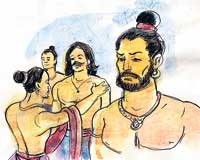
Prince Veerabahu~This article is part of a continuing series on the ‘Mahavamsa,’ the recorded chronicle of Sri Lankan history~ 1. According to a chronicle in Siam (Thailand), King Dharmaraja and the King of Siam were friends. They sent envoys to Sri Lanka, to obtain a Buddha statue. It is believed that the statue they obtained could be seen to date in Siam. There is also mention of the fact that King Parakramabahu II too sent envoys to Tambalinga. That was on a request to get down a good Buddhist priest from there.
2. According to all these references, King Chandrabhanu is a king who had maintained religious relations with Sri Lanka. It is worth investigating why he went against Sri Lanka, in spite of all these friendly relations. Magha too had come from Malaysia and there are references to show that most of his soldiers were Malay nationals. Even when King Chandrabhanu came, the northern part of Sri Lanka, was under Magha's rule. King Parakramabahu II was getting ready to wage war against him. 3. There were some battles between these two sides. Chandrabhanu invaded the area where King Parakramabahu II was holding his sway. This would have been a strategy to divert the attention of the Sinhala soldiers from the north. It was also to minimize the suffering inflicted on Magha and his men by King Parakramabahu II. So we realize, that Magha and Chandrabhanu belonged to the same nationality. There is reason for scholars to believe that both of them were working in unison. 4. Now there is another episode which is only a guess, as there is no historical evidence to prove it. Thai nationals are believed to have had an area of rule in the valley called 'Menon.' Chandrabhanu's kingdom had suffered attacks from them. There is another school of thought which says that it was due to this problem that Chandrabhanu would have been pushed to invade Sri Lanka to establish his power here. An inscription found in the 'Red' plateau says so. 5. The Sinhala priests who mastered the 'Vinaya Pitaka' of the 'Blessed One,' are said to have been instrumental in getting a temple built. This was called 'Abhayagiri' in Anuradhapura. This shows that in addition to the religious relations maintained, the Sinhala monks had seen to the building of temples too. However, Malay power spread in the coastal regions very soon. The coastal areas of North-West and the South came under them. King Parakramabahu II had to act soon. 6. He soon strengthened his army and organized everything to go to war. By this time, the Sinhala army had a very powerful warrior. He was Prince Veerabahu, who was the nephew of the king. He was skilled in all martial arts and had mastered war strategy. He gave a good training to the Sinhala soldiers. Everything was now ready for the battle. At an auspicious hour, the army marched forward.
7. They besieged the fortresses of Chandrabhanu and began to attack. The Malays retaliated and it was tough fighting. They began to shoot poisoned arrows and that caused a lot of danger to the Sinhala forces. But still the soldiers were not discouraged. They continued to fight with determination and were able to record a victory. Malays were chased away. Victorious Prince Veerabahu, did not march to Dambadeniya straight away. Instead, he along with his army, marched to Dondra. 8. There the prince worshipped and paid his respects to God Upulwan. He joined his army in performing a 'Deva Pooja' here. They also built a pirivena there and named it 'Sanghika.' Its surrounding was beautifully decorated. As anyone beholding this area, deserves pleasure, it was named 'Nandana.' After all this, Prince Veerabahu, accompanied by his army, went to Dambadeniya. |
|
||||||
|| Front
Page | News | Editorial | Columns | Sports | Plus | Financial
Times | International | Mirror | TV
Times | Funday
Times || |
| |
Reproduction of articles permitted when used without any alterations to contents and a link to the source page.
|
© Copyright
2008 | Wijeya
Newspapers Ltd.Colombo. Sri Lanka. All Rights Reserved. |

